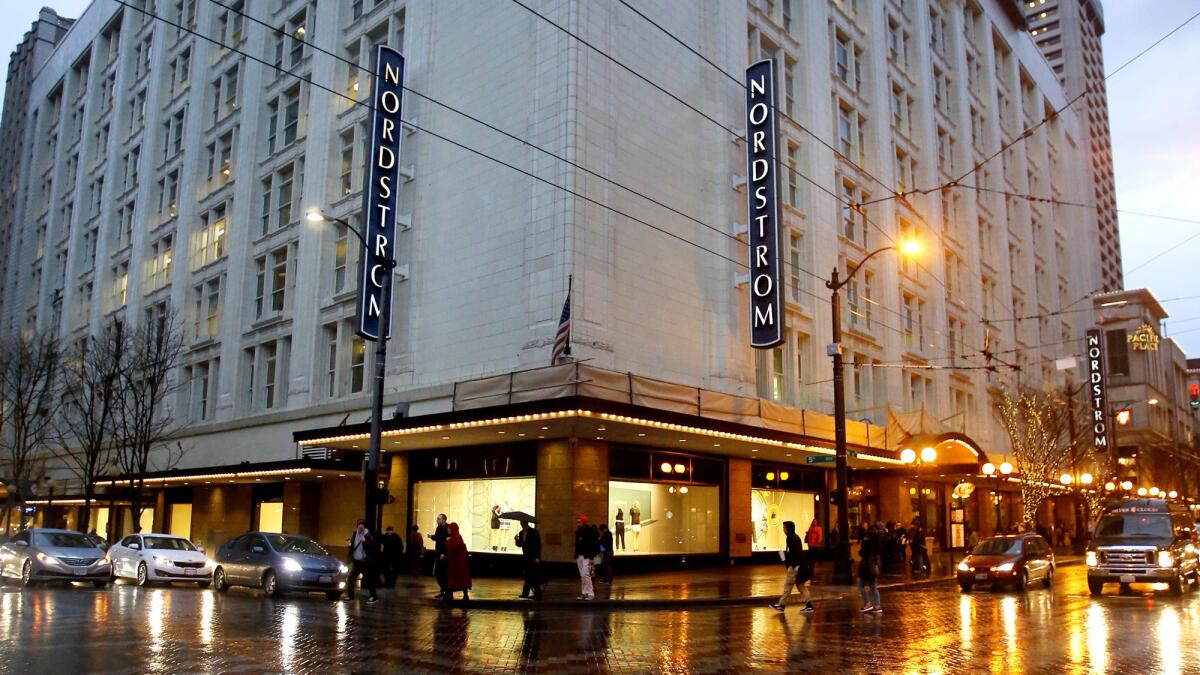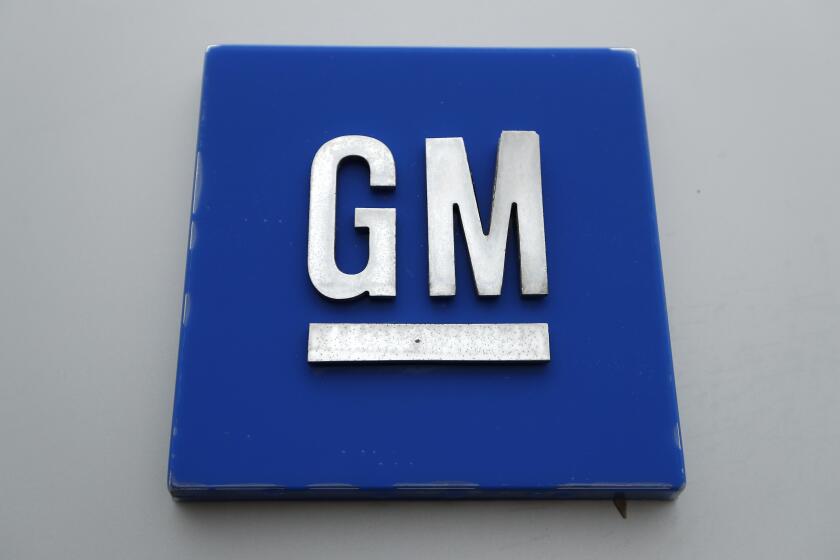Why have upscale retailer Nordstrom and other apparel giants lost their luster?

- Share via
In mid-August of last year, warning signs at the Seattle headquarters of Nordstrom Inc. first became apparent.
Up to that point, the upscale apparel retailer, with $14 billion in annual sales, had enjoyed several years of steady sales growth and expansion. Its stock had climbed to a record high of about $80 a share.
“Then, all of a sudden,” that growth began stalling in a “very strong” way, Michael Koppel, Nordstrom’s chief financial officer, told an industry conference in June. “For something that happened that quickly, it just begs a lot of questions.”
Nordstrom is still sorting through those questions because its sales slowdown has carried into 2016, sharply cutting the company’s profit, slashing its stock price by nearly half and prompting a downgrade of its credit rating. The impact is particularly felt in California, where Nordstrom has 25% of its floor space.
Nordstrom, founded as a shoe company more than a century ago, is grappling with many of the same massive changes roiling other major apparel-heavy department stores such as Macy’s Inc. and Kohl’s Corp: a decline in mall traffic, lower consumer spending on apparel, shoppers’ increasing habit of buying online and heightened competition from Internet players such as Amazon.com Inc.
“A lot of the factors that are hurting everybody else are starting to splash onto Nordstrom,” said Richard Church, managing director for retail at the research firm Discern Group Inc.
Nordstrom is known for its exemplary customer service, liberal return policy and in-store amenities. The company also prides itself on selling apparel that buyers see as unique, fashionable and worth a premium price.
“Nordstrom, to me, has always been the best of the best,” said Ronald Friedman, co-head of retail at the Marcum accounting and advisory firm.
But Erik Nordstrom, a Nordstrom co-president, said his company needs to upgrade on all fronts to get sales growing again.
“If we’re going to improve our business, we have to improve the customer experience and we have to improve the product,” he said in a telephone interview. “Our results are not where we want them. We need to get better.”
In addition to 121 traditional, full-line stores located mostly in shopping malls, Nordstrom also has 200 off-price Nordstrom Rack stores that have been a key driver of its sales growth.
The company also operates online versions of both chains, which are critical because “mall traffic overall has been soft over the last probably couple [of] quarters,” James Nordstrom Jr., the company’s executive vice president and Erik Nordstrom’s second cousin, told analysts in May. “When we see mall traffic go down, it hurts us.
“We’re looking at how can we — regardless of the mall that we’re in — give the customer a compelling reason to make a trip to the store?” he said.
It’s a problem Nordstrom’s rivals also face as more shoppers, especially the millennial (18 to 34) population, buys more clothes and accessories on the Internet. Others are choosing to spend less on apparel or are shopping at lower-price competitors.
Macy’s in January said it would close 40 of its 770 stores. Kohl’s posted lower sales and profit in the latest quarter.
“Overall spending on apparel is not growing,” said Helena Song, a credit analyst at Standard & Poor’s Corp. “Nordstrom is a leader in the department-store sector, but it’s not immune to these headwinds.”
Friedman said the “millennials’ shopping habits are completely different from the baby boomers’ ” who traditionally shopped at a Nordstrom store. “Nordstrom is finally getting caught up in it.”
That was first evident in the holiday-filled fiscal fourth quarter of 2015, when Nordstrom’s same-store sales — a key retail gauge measuring sales of stores open at least one year — rose a scant 1.0% from a year earlier.
Citing those “weaker-than-expected operating results,” Standard & Poor’s in February downgraded Nordstrom’s credit rating to BBB+ from A-.
Then, in Nordstrom’s fiscal first quarter ended April 30, its same-store sales fell 1.7% — its first quarterly drop in several years. Worse, the same-store sales for Nordstrom’s U.S. full-line stores dropped 7.7% from a year earlier.
Wall Street expects an even bigger decline in Nordstrom’s overall same-store sales, 3.2%, in the quarter ending this month before it turns positive again later this year, according to analysts polled by FactSet Research Systems Inc.
In addition, Nordstrom’s first-quarter profit plunged 64% from a year earlier, to $46 million, prompting the company to slash its full-year earnings forecast. The sharp drop in its stock, which closed Friday at $40.86 a share, has wiped out more than $6 billion of Nordstrom’s total market value.
Asked whether Nordstrom planned any store closures as a consequence, Erik Nordstrom said, “We don’t have any announcements to make. But I wouldn’t say it’s off the table, either. We look at our store portfolio all the time.”
The ongoing migration of shoppers to the Internet was expected, but the speed at which the shift occurred starting in the second half of last year was not, the co-president said. “There was an acceleration there that was surprising,” he said.
Regardless, Nordstrom said his company is trying to keep its clothing relevant to shoppers in part by selling popular brands that have limited distribution elsewhere. Three examples found in Nordstrom stores: Beyonce’s Ivy Park active wear, J. Crew’s Madewell brand and Topshop, a British apparel brand.
“That category is becoming more and more important,” Nordstrom said. “Our customers look to us to see what’s new.”
Some observers see Nordstrom’s problems as temporary. While noting that the company’s first-quarter results were “shockingly bad,” its “underlying business is a lot healthier than it appears,” Adam Levine-Weinberg of investment website the Motley Fool wrote in May. He also disclosed owning Nordstrom stock at the time.
“Nordstrom’s customers are still willing to pay full price for unique, compelling merchandise,” he wrote.
Perhaps, but overall, “the consumer is just more value-driven than ever,” said Song of S&P. That’s why the discount Nordstrom Rack stores “will continue to be a key part of their growth story,” she said.
Marcum’s Friedman said Nordstrom’s future also might include smaller full-priced stores or “showroom” locations that are less costly to operate. They would allow shoppers to still comb through the merchandise — with the help of Nordstrom’s familiar customer service — but the clothes would be delivered rather than carried out.
“They’re going to ship it to you the next day from a warehouse,” he said.
In the meantime, the key to getting Nordstrom’s sales growth on the upswing again is quickly adapting to consumers’ changing shopping habits while still offering in-demand apparel, Nordstrom said.
The boundaries between physical stores and Internet shopping “are just less and less relevant,” he said. “Increasingly customers — even in the same journey — are combining online elements and offline elements” when they buy clothes.
“We don’t have online customers or store customers. They’re just customers,” Nordstrom said. “The focus of what we do is always the customer. That may sound obvious, but it is harder than that sounds.”
For more business news, follow James F. Peltz on Twitter: @PeltzLATimes
ALSO
Macy’s tests artificial intelligence as a way to improve sales
Verizon buys Yahoo for $4.83 billion; Marissa Mayer says she’ll stay
Southern California’s aerospace industry, long in decline, begins to stir
More to Read
Inside the business of entertainment
The Wide Shot brings you news, analysis and insights on everything from streaming wars to production — and what it all means for the future.
You may occasionally receive promotional content from the Los Angeles Times.











